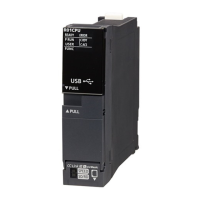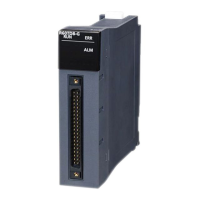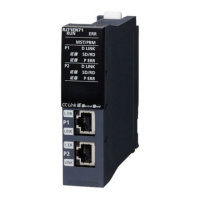446
28 FUNCTIONS
28.2 System Switching
Operation at system switching
The following table shows the operations of the CPU modules of when the control system and the standby system are
switched.
These operations are for when both systems are operating and the operating statuses of the CPU modules are the same.
*1 The operation varies in a program executed in both systems. ( Page 482 Operation at system switching)
*2 The operation varies when the signal flow memory is not transferred. ( Page 506 Instructions whose operations vary depending on
tracking of the signal flow memory)
*3 The operation varies when the standby system output setting is enabled. ( Page 485 Redundant System Operation Setting)
Item New control system CPU module New standby system CPU module
Program execution Initial execution
type program
This type of program is not executed.
However, when an initial execution type program has
not been completed on the old control system at
system switching, it is executed again from its head.
The program execution stops.
*1
Scan execution type
program
This type of program is executed from the step 0.
Fixed scan
execution type
program
The fixed scan execution interval is measured from 0. The program execution stops.
Standby type
program
This type of program is not executed.
Event execution
type program
• Interrupt program: The program is executed when
an interrupt factor is generated.
• ON of bit data (TRUE): The program is executed
when a specified factor is generated.
• Passing time: A specified time is measured from 0.
Tracking transfer Tracking data is transferred to the new standby
system.
Tracking data is received. However, when a stop error
occurs on the new standby system, the new standby
system does not receive the tracking data.
Online change Write operation at system switching continues.
Device/label memory The state before system switching is held.
Signal flow memory
( Page 461 Tracking transfer setting for
the signal flow memory)
• In backup mode, the signal flow of the old control
system is reflected.
*2
• In separate mode, the signal flow of the old standby
system is reflected.
The state before system switching is held.
Special relay (SM), special register (SD) The state before system switching is held.
However, when the CPU module is in the RUN state, SD520 to SD531 are cleared.
Output (Y) The state before system switching is held and output
refresh is performed.
After the output (Y) is turned off, output refresh stops.
*3
Direct access input (DX) In the program execution after system switching, data
is fetched when an instruction using the direct access
input (DX) is executed.
No operation is performed because the program does
not operate.
*1
Direct access output (DY) In the program execution after system switching, data
is output when an instruction using the direct access
output (DY) is executed.
FROM/TO instructions In the program execution after system switching, this
instruction is executed when the instruction execution
condition is satisfied.
Instruction that requires several scans In the program execution after system switching, this
instruction is executed when the instruction execution
condition is satisfied.
• No operation is performed because the program
does not operate.
*1
• When the systems are switched while the instruction
is being executed, the instruction execution
continues. However, the completion device does not
turn on in the new standby system, and it turns on in
the control system after the next system switching.
*1
Constant scan Constant scan is enabled. • The constant scan function is disabled in the backup
mode.
• The constant scan function is enabled in the
separate mode.

